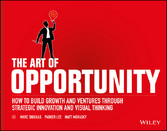
The Art of Opportunity - How to Build Growth and Ventures Through Strategic Innovation and Visual Thinking
von: Marc Sniukas, Parker Lee, Matt Morasky
Wiley, 2016
ISBN: 9781119151593
Sprache: Englisch
288 Seiten, Download: 3454 KB
Format: EPUB, auch als Online-Lesen
Mehr zum Inhalt

The Art of Opportunity - How to Build Growth and Ventures Through Strategic Innovation and Visual Thinking
Chapter 1
When Thomas Ebeling became the new CEO of ProSiebenSat.1 Media AG (Pro7) in 2009, he faced a familiar problem: how to grow the business. Pro7 was the leading media company in the German TV advertising market with their core business of free TV—financed by advertising. Mr. Ebeling's challenge was how to grow the business and achieve over €1 billion in incremental revenues by 2018. Resorting to traditional strategic moves, expanding existing businesses and offerings, would certainly not do the trick.
Pro7 crafted a unique strategy for a new business area making TV advertising available to start-ups, and small and medium-sized companies, two customer segments that traditionally couldn't afford TV advertising and were seen as unprofitable by the industry. One year after the new business had been launched, it had already generated €20 million in profit. Five years later, Pro7 had achieved tremendous success with its new strategy. In fact, the strategy worked so well that in 2015, the €1 billion plus target was increased to €1.85 billion.
Business professionals and scholars admire achievements like these and wonder how Pro7 tapped into new markets and developed new business areas. Finding and seizing opportunities for new growth is, after all, the Holy Grail of business. And if Pro7 didn't use traditional growth methods, exactly how did they arrive at new offerings, complete with innovative business models and revenue models, to reach entirely new customer segments?
What Is Strategic Innovation?
The Art of Opportunity is about how strategic innovation and business design thinking can grow existing businesses and create completely new ones by discovering opportunities for new growth and crafting strategies to seize these opportunities.
Strategy is essentially about making choices about where to play and how to win. Strategic management theories offer frameworks to guide our thinking, help develop answers to these questions, and make such choices. The approach and concepts of The Art of Opportunity provide fresh and modern ways to look at these questions, enabling you to come up with more innovative answers than yesterday's traditional strategic management approaches might offer.
Traditional Strategic Management
On a Business Level, traditional strategic management 2 is primarily concerned with where to play and how to win. Where to play is framed as a choice of industry and product/market combination. Simply speaking, you pick an industry, say air transportation, and a market, for example continental flights in the United States, and you define your offering within this market, for example low-cost direct city-to-city flights.
How to win is mostly defined as achieving competitive advantage. Michael Porter's classic generic choices 3 about how to achieve competitive advantage are to either (1) be a cost leader, (2) differentiate your offering, or (3) focus on a niche. Treacy and Wiersema4 offer three choices to win: (1) product leadership (offer the best product by focusing on product innovation); (2) operational excellence (be a price and convenience leader by focusing on low cost, lean and fast production, and speedy delivery); or (3) customer intimacy (win by creating loyal customers through tailored offerings and focusing on customer relationships).
Strategy development and execution thereby follow a linear process of analyzing the situation and environment, followed by developing a strategy, and finally executing it. The underlying principle is that the development of the strategy has to be completed before the strategy can be executed.
To be clear: we don't suggest that these traditional strategic management approaches do not work. For some organizations and in certain industries, they work extremely well, if applied in the right way. Yet a lot of companies also struggle when attempting to achieve their growth and innovation targets with these traditional frameworks.
Strategic Innovation
How Does our Take on strategic innovation differ from these more traditional approaches?
First of all, we shift the objective from focusing on achieving competitive advantage by simply being cheaper or different to finding and seizing opportunities by creating value. Traditional strategy is focused on the company, trying to position the company as being a cost leader, being different, focusing on a niche, or something similar, as we have seen. But being cheaper or different alone is simply no longer enough to be successful (if it ever was). The Art of Opportunity takes an entrepreneurial stance, looking beyond positioning your company to a larger holistic perspective that involves creating value for your customer, your firm, and your business ecosystem. Only by creating value for a multitude of stakeholders does your company have the potential to be successful. And creating value is achieved through more than simply offering a cheap or different product, to include products, services, the entire customer experience (CX), your business model, and your revenue model.
Having described the differences, let's examine The Art of Opportunity's approach to designing your strategy. The book offers a fresh perspective to look at three areas: (1) Where to play, (2) How to play, and (3) How to win.
Where to Play: Find Your Opportunity
Where to play is all about finding your new growth opportunities. Instead of focusing on industries, markets, and competitors, we focus on exploring:
- Customers and noncustomers,
- Customer needs and expectations,
- The customer experience, including barriers to consumption and hurdles to satisfaction.
Opportunities are a function of the chosen customer segment, its needs, and expectations toward the solution offering, and current barriers to consumption or hurdles to a satisfactory customer experience.
How to Play: Craft Your Strategy
How to play is all about crafting the strategy and designing the business required to seize these opportunities. Defining how to play requires you to craft your:
- Offering: The unique blend of products, services, and the customer experience.
- Business model: The necessary set of activities to create and deliver your offering, in a specified sequence of these activities, employing the skills, capabilities, and assets necessary to do so and identifying who provides them, plus how you work with your partners.
- Revenue model: The combination of your revenue streams, pricing mechanisms, and payment schemes.
How to Win: Create Value
Instead of simply addressing cost and pricing or product/service differentiation, we focus on creating:
- Customer value: Solving your customers' needs better than anybody else by removing barriers to consumption and hurdles to satisfaction.
- Firm value: Crafting a strategy that will generate value for your company in terms of opening up further opportunities and operational and financial benefits.
- Ecosystem value: Creating strategic, operational, and financial value for your partners and the larger ecosystem your company is embedded in and relies on.
Finally, we show how the process for strategy making and execution and for building new growth businesses is neither entirely linear nor completely iterative. Instead we will illustrate how companies go through an iterative process consisting of three phases characterized by a bias toward action over analysis and planning.
What Is Business Design Thinking?
If Strategic Innovation Focuses on the content of your new growth strategy and the process of crafting that strategy, business design thinking focuses on the practices that enable your team to achieve success more effectively and efficiently.
In short, business design thinking is a collection of principles (of which visual thinking is a key methodology) to help understand, address, and develop solutions to business problems. It can also be considered a strategic mind-set (or way of working) that focuses on understanding audiences, visualizing ideas and information, working collaboratively, and learning iteratively, all while keeping an eye on a holistic picture. This approach has been proven to open new channels to creativity, actively engage participants and stakeholders, build clarity and consensus, and accelerate speed to market.
The five Principles of Business Design Thinking:
- Keep a human-centered focus: Put people, not objects, at the heart of your story. An empathetic, human-centered focus creates value for not only the customer, but all stakeholders, including employees, shareholders, suppliers, and vendors.
- Think visually and tell stories: Visualization enables us to more easily and clearly share our ideas and develop them with others. Visual storytelling brings ideas to life and creates the understanding and alignment that accelerates decision making.
- Work and co-create collaboratively: Bring together diverse perspectives. Creating solutions to a shared problem within a multi-disciplinary group builds support and can generate breakthrough ideas.
- Evolve through active iteration: Build to understand. Iteration enables you...









